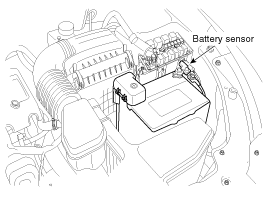Description
Vehicles have many control units that use more electricity. These units
control their own system based on information from diverse sensors. It is important
to have a stable power supply as there diverse sensors giving a variety of information.
Battery sensor is mounted on battery (-) terminal. It transmits battery voltage,
current, temperature information to ECM. ECM controls generating voltage by
duty cycle based on these signals.
ąÜčāą┐ąĖčéčī čüą╝ą░čĆčéč乊ąĮ apple airpods 2
www.livitoys.ru.

|
When battery sensor signal fault occurs, inspect the vehicle parasitic
draw in advance after inspecting the sensor because the sensor will
behave abnormally when the parasitic draw is more than 100mA. (Refer
to vehicle parasitic current inspection)
|
|
Perform the following process after replacing the battery sensor.
| 1. |
Ignition switch ON/OFF.
|
| 2. |
Park the vehicle about 4 hours.
|
| 3. |
After 4 hours later, check the SOC (State of charge) of
battery using GDS.
|
|
|
For the vehicle equipped with a battery sensor, be careful not
to damage the battery sensor when the battery is replaced or recharged.
| 1. |
When replacing the battery, it should be same one (type,
capacity and brand) that is originally installed on your vehicle.
If a battery of a different type is replaced, the battery sensor
may recognize the battery to be abnormal.
|
| 2. |
When installing the ground cable on the negative post
of battery, tighten the clamp with specified torque of 4.0~6.0N.m
(0.4~0.6kgf.m, 3.0~4.4lb-ft). An excessive tightening torque
can damage the PCB internal circuit and the battery terminal.
|
| 3. |
When recharging the battery, ground the negative terminal
of the booster battery to the vehicle body. If the negative
cable from a battery charger is connected to the negative terminal
of the battery, the battery sensor can make an error. In this
case, repeat the above process for battery sensor replacement
(1~3) after disconnecting and reconnecting the battery connector.
|
|
Removal and Installation
1.
Disconnect the terminals from the battery.
Tightening torque :
(+) terminal (A) : 7.8 ~ 9.8N.m (0.8 ~ 1.0kgf. ...
See also:
Do not use methanol
Fuels containing methanol (wood alcohol) should not be used in your vehicle.
This type of fuel can reduce vehicle performance and damage components of the fuel
system.
CAUTION
Your New Vehicle L ...
Audio system
✽ NOTICE
If you install an after market HID head lamp, your vehicle's audio and electronic
device may malfunction. ...
Turn signals and lane change signals
The ignition switch must be on for the turn signals to function. To turn on the
turn signals, move the lever up or down (A). Green arrow indicators on the instrument
panel indicate which turn ...
 Hyundai Sonata: Battery Sensor. Description and Operation
Hyundai Sonata: Battery Sensor. Description and Operation
 Battery. Repair procedures
Battery. Repair procedures Starting System
Starting System